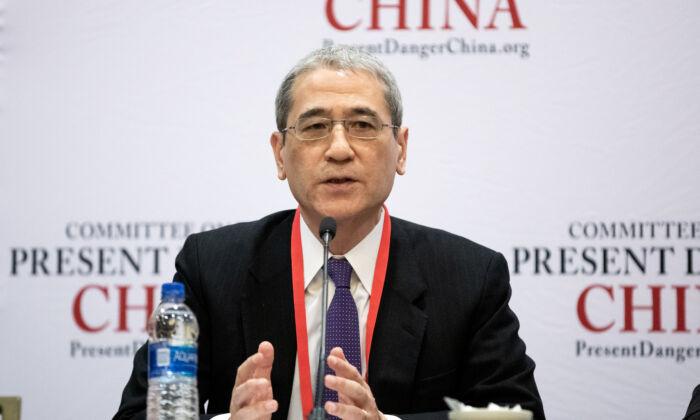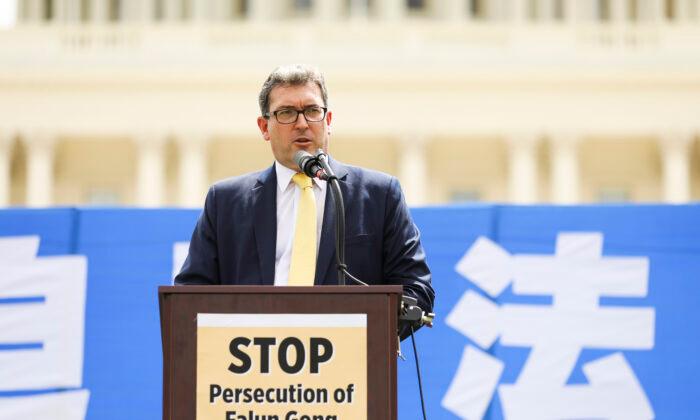“Bernie Sanders’s bill, he calls it ‘Medicare for All.’ In reality, it’s Medicare for none,” said Chris Jacobs, author of “The Case Against Single Payer: How ‘Medicare for All’ Will Wreck America’s Health Care System―And Its Economy,” in an interview with The Epoch Times’ program “American Thought Leaders.”
In Jacobs’s view, “Medicare for All” would curtail rather than increase many people’s access to high-quality health care.
Because health care would become “free,” demand for health care services would rapidly grow. “As anyone who’s ever been to an all-you-can-eat buffet knows, making something free means you want to consume more of it. Now I don’t think people will voluntarily sign up for heart surgery because it’s free, but you will see additional demand for health care,” Jacobs said.
At the same time, because of quarterly budget limits, hospitals would likely have to lay off some employees while cutting the pay of others.
The result, Jacobs said, would be longer wait times and less access to care, especially in highly specialized fields.
“In other countries that have socialized medicine systems—Canada, Great Britain—they ration access to care. The poorest and the sickest patients a lot of times can’t get care because government bureaucrats decide based on cost principles who does and does not get treated,” he said.
In Canada, a country of 37 million people, “there are over 1 million individuals waiting on waiting lists for treatments.”
“The average wait is about five months. In some specialties it’s even longer. [In] orthopedic surgery, it’s about 10 months. Think about that. You get diagnosed that you need a hip replacement in January. You'll be lucky if you get the hip replacement by Christmas,” he said.
A 2016 survey of patients in 11 countries, including the United States and Canada, found that Canada performed among the worst in terms of access to primary care. Canada had the lowest percentage of patients (43 percent) who said they could get an appointment on the same or next day to see a doctor or nurse. And it had the highest percentage of patients (29 percent) who said they waited four or more hours in the emergency room.
“Single-payer [in America] would be one of the worst things for the Canadian health care system because the United States is the pressure relief valve on Canada’s single-payer system,” Jacobs said.
Similarly, in Britain, “patients end up going without treatment—specialized cancer treatments, cystic fibrosis drugs, all these sorts of treatments, because they don’t meet government bureaucrats’ arbitrary cost targets,” he said.
The British health care system’s severe lack of resources and funding came to the forefront when a bad flu season swept the nation and crippled its health care system. Britain had to cancel more than 50,000 non-urgent operations, and an emergency room doctor publicly apologized for “Third World conditions of the department due to overcrowding.”
“The system is so underfunded that a simple little thing like the flu, which we know happens every winter, causes the system to go into chaos. And people lying on gurneys in the emergency room for hours and hours and hours on end,” Jacobs said.
Despite all of this, Medicare for All would actually cost more, not less, for most Americans, Jacobs said. Emory University professor Kenneth Thorpe’s analysis of Sen. Bernie Sanders’s 2016 single-payer health care plan found that 71 percent of Americans would pay more under the single-payer health care plan.
And 85 percent of taxpaying Medicaid recipients would actually pay more for Medicare for All, Jacobs said, because many Medicaid recipients receive health care coverage for free, so any additional payroll taxes or premiums to fund single-payer health care would make them worse off.
“Socialized medicine would raise taxes so high that Sen. Bernie Sanders’s home state of Vermont had to shelve its plans for single-payer health care, after estimates suggested the plan would have required a 9.5 percent increase in income taxes, plus an 11.5 percent increase in payroll taxes,” Jacobs wrote in his book.
An Uninformed Public
Many Americans are not aware of key aspects of single-payer health care, as Jacobs noted in his book.According to a poll by the National Opinion Research Center at the University of Chicago, 55 percent of all respondents thought that enrollment into Medicare for All would be optional.
But the truth is that Medicare for All would make private health insurance “unlawful,” so around 300 million Americans would lose their existing coverage, Jacobs said. Less than 12 million people—Americans covered by the Indian Health Service and Department of Veterans Affairs—would be able to keep their coverage.
In a recent poll, the Kaiser Family Foundation found that those who favored a national health insurance plan were also significantly more likely to believe that they would be able to keep their current health insurance. But support for Medicare for All decreased substantially when people were told Medicare for All would lead to more delays to getting treatment, require most Americans to pay more in taxes, and eliminate private health insurance.
As Jacobs highlighted in his book, Medicare for All would mean that patients seeking private care would have to find a doctor who only treats private patients, because doctors who operate in the government system are not allowed to treat patients privately except for in procedures that are not covered, like cosmetic surgery.
This is more radical than what is currently in place in Canada and Great Britain. In Britain’s system, doctors working for the National Health Service by day are able to work as private practitioners by night. And in Canada, about 25 million Canadians, which is around two-thirds of the population, have some kind of supplementary private health coverage.
Medicare for All would especially hurt seniors, Jacobs said, because it would abolish the current Medicare program and take away popular Medicare Advantage plans, which are private health insurance plans. “Medicare Advantage plans have grown substantially in the past 10 years. Those would all go away. So over 20 million seniors, they would lose their coverage,” he said.
“The funny thing is, Democrats raided Medicare to pay for Obamacare. Now they’re raiding Medicare again to pay for this socialized medicine.
Widespread Inefficiency
“The other problem is, by creating a single-payer system, what doctors are paid is going to be determined by government bureaucrats,” Jacobs said.“We’ve seen with Obamacare that they couldn’t operate a website. They couldn’t create a website to allow people to buy health insurance.
“What makes anyone think that the federal government will know the exact correct price of every procedure, every health care service performed for every physician in every hospital across the United States? It’s not going to happen. You’re going to get more distortions in the marketplace.”
The failures of government bureaucracy were highlighted by the wave of scandals that plagued the Department of Veterans Affairs in 2014. The biggest scandal was in Phoenix, where as many as forty veterans died, allegedly while waiting for care. Jacobs said most of the scandals were in the Southwest, because the government had too many hospitals and clinics in the Northeast, the Rust Belt, and the Midwest, and not enough in the Southwest, where more and more veterans are retiring.
“The population is shifting to the south and the Southwest. It shows the government can’t keep up and adapt and allocate resources. It’s another indication of why centralizing more resources and power in the federal government will lead to poor-quality care,” he said.
At the same time, Medicare for All would allow for more corruption, in his view. “Single-payer legislation gives virtually unchecked powers to one branch of government—and unelected bureaucrats at that,” he wrote in “The Case Against Single Payer.”
The existing Medicare and Medicaid programs saw $84.7 billion in total fraud and improper payments last year, Jacobs said.
“I thought it was very interesting that the Democrats hosted their first presidential debate in Miami. One of Miami’s biggest industries has been health care fraud, shady enterprises created in storefronts, suburban storefronts, for the primary purpose of bilking the government out of money, for billing for services never provided. You see healthy people walking out and coming out of offices with $1,000 powered wheelchairs,” he said.
Economic Shocks
The radical changes required to implement Medicare for All would lead to major shocks to the American economy, in Jacobs’s view.First, 540,000 insurance industry employees would be out of work. At the same time, “physicians and hospitals will get paid less under single-payer,” he said. “The only way they can try to bring the costs under control is to pay them less.”
A study in the Journal of the American Medical Association estimated there would be 1.5 million job losses in hospitals. “That’s just in the hospital sector. Then you add together the physicians’ offices, the nursing homes, all of the other ancillary health care services. You’re talking about millions of potential job losses,” Jacobs said.
“The other economic shock would come from the tax increases needed to fund single-payer. How do you pay for a 30 to 40 trillion program?”
The White House Council of Economic Advisers found that single-payer health care would leave each household an average of $17,000 poorer each year, accounting for both tax increases and no longer having to pay for health care—a whopping 19 percent decrease.
The higher taxes would stifle economic growth and create deadweight loss, inefficiencies in the economy.
Furthermore, single-payer health care would “likely eradicate at least half a trillion dollars in stock market value from various health care-related companies,” Jacobs wrote in his book. This would mean a major hit to stock-owning Americans, whether they’re directly or indirectly affected through mutual funds and retirement accounts.
The solution to America’s health care woes is not Medicare for All, in Jacobs’s view.
“We need to make sure that we have a sustainable safety net, and make sure that Medicare and Medicaid do not bankrupt our country for our next generation,“ he said. ”We already have $21, $22 trillion of debt. We need to make sure that we have a sustainable safety net for the poor and vulnerable without bankrupting our entire country in the process.”





